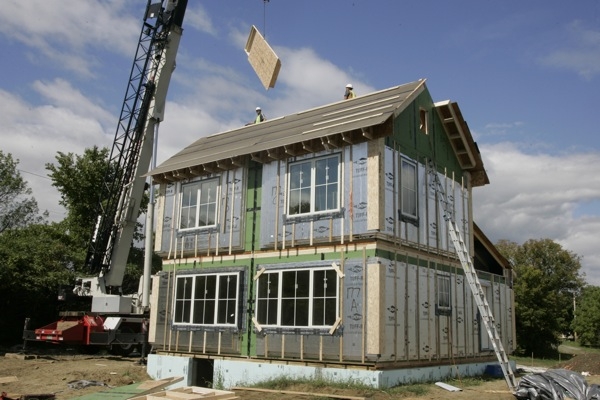
View the Audio Slideshow of the Palmer house construction below
(Host) What if you could heat a small house with about as much energy as it takes to run a hair dryer-even during a cold winter?
That’s what one family from Charlotte is about to do, thanks to Habitat for Humanity. The Green Mountain chapter is building a house so air-tight that it can be warmed mostly by the sun shining through the windows.
VPR’s Charlotte Albright recently watched the roof go up.
(Sneak up construction ambience, fade under copy)
(Albright) Around 8:30 on a gray, drizzly September morning, a giant crane gently begins laying modular frame walls and a roof on a foundation in the middle of a scenic meadow.
If all goes as planned, this boxy 13-hundred square foot house will meet extra strict standards for energy efficiency set by the Passive House Institute.
To Katie Palmer and her young two sons, watching wide-eyed from the sidelines, seeing the exterior walls come together in about a day seems almost surreal, like a life-sized video game with a happy ending.
(Katie Palmer) "The opportunity to have a home that is ours, that we are paying the mortgage on, that’s affordable, that’s in a beautiful location-you know my boys are going to come home from college to the house they grew up in."
And this certainly is the house her seven year old Charlie wants to grow up in.
(Charlie) "When you go inside, I was just shocked by what I saw. I had some tears during that tour because, I mean you can’t help it, you’re getting a new house! I mean, there’s nothing much you can do but cry and be happy about it."
(Albright) Of course, there is a lot to do for the workers on site. To be certified by the Passive House Institute, this house may consume no more than 1 BTU per square foot per heating degree day. It meets that goal with super-insulated walls, windows, and doors, and a state-of-the-art ventilation system that allows carbon dioxide to escape.
With sun shining through south-facing windows, and heat radiated from appliances and human bodies, designers expect the pre-fab home to use 75-95 per cent less energy than most new buildings that meet U-S energy efficiency standards. Boston-based architect JB Clancy grins as he watches the roof go on.
(Clancy) And what’s exciting about this project is that it will be the first of its kind built in a modular fashion in this country. There are some that have been built with panels and such but this is the first that’s been built in boxes in a factory, delivered to a site, and assembled. So a number of firsts and I think the most rewarding part is to see it come together full scale and to see the reactions on the family’s faces, to watch it come up.
(Albright) Passive House technology got its start in Europe, and migrated to America via Urbana, Illinois — headquarters for the Passive House Institute.
In Vermont, building consultant Peter Schneider, a Charlotte resident who manages projects for the Vermont Energy Investment Corporation, figured it would be especially appealing to Habitat for Humanity:
(Schneider) And when I approached them with this idea of re-defining affordable housing, no longer just thinking about really low initial costs and a low mortgage but thinking about "what are some of these financial burdens that carry on with the homeowner such as energy costs which are continuing to escalate, they really understood where I was coming from and agreed to pursue this.
(Albright) With almost religious zeal, passive house proponents see super-insulation with super-modern materials as a way to help low-income homeowners AND to ease the global energy shortage.
Chet Pasho is the building science consultant for the company that builds these modules, Preferred Building Systems.
(Pasho) "We get hung up with the idea that we need to do, uh, alternative energy-we need solar energy, we need geothermal energy, this sort of thing. My goal is, reduce the need for as much energy to begin with, and then all these other technologies become scalable."
(Albright) If this house were built conventionally, instead of by volunteers, it would cost about $150 per square foot. That doesn’t include the lot, which was donated to Habitat for Humanity by the town of Charlotte. With a zero percent mortgage, Katie Palmer says she’ll cut her yearly housing costs by at least sixty per cent. And she’ll also shrink her carbon footprint, which is important, as data from the US Energy Information Administration show that buildings are responsible for almost half the greenhouse emissions each year.
Strolling through what will be the kitchen-dining area, Green Mountain Habitat for Humanity director Dave Mullen says other chapters are warming up to passive houses, too, even if that means raising more money up front to lower energy costs in the long run.
(Mullen) And that’s a challenge, so we’ll need to reach out even further into the community and tell the story about Habitat and what a difference it makes in the lives of people in our own communities.
(Albright) The Green Mountain Habitat chapter plans to build two other energy-efficient houses in this meadow, though they may not be modular. Kate Palmer and her sons hope to be all moved into theirs by Christmas.
For VPR News, I’m Charlotte Albright in Charlotte.
Slideshow photos by Herb Swanson